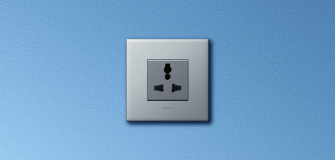Power Up Through the Ages: The Evolution of USB Sockets
Our trusty electronic companions are constantly evolving, and the way we juice them up
needs to keep pace. Enter the ever-reliable USB socket, a ubiquitous presence in our daily lives. But did you know that the USB socket, like our smartphones, has undergone a fascinating transformation? Let’s take a trip down memory lane and explore the journey of the USB socket, from the classic USB-A to the cutting-edge USB-C.
The OG: The Enduring Reign of USB-A
The granddaddy of USB sockets, the USB-A, first emerged in the mid-1990s. This rectangular port, with its flat, metal tab in the center, became the go-to for connecting all sorts ofdevices—printers, scanners, external hard drives, and, of course, our early mobile phones. Remember those chunky phones? They relied on the trusty USB-A for their power needs.
While not the fastest charger around, the USB-A offered a standardised connection, eliminating the need for a different cable for every device (a struggle we knew pre-USB!). Even today, the USB-A remains a popular choice, especially for peripherals and budget-friendly devices. Eshop by Legrand [Eshop byLegrand] offers a wide variety of surge protectors and extension cords equipped with USB-A ports, making them perfect for creating a charging station for your entire family’s devices. Imagine the convenience of having a single power strip where everyone can plug in their phones, tablets, and even gaming consoles – all at once!
A Brief Interlude: The Niche of USB-B
The world of USB sockets wasn’t entirely dominated by the A-type. While the USB-A reigned supreme for most devices, its counterpart, the USB-B, catered more to specific needs. This squarish port with a slightly recessed center section was primarily used for printers, scanners, and some external hard drives.Unlike its A-type counterpart, the B-type wasn’t as versatile and could be inserted upside down, leading to frustration for some users. Thankfully, USB-A’s dominance meant that USB-B use wasn’t as widespread.
Enter the Champion: The All-Powerful USB-C
The 21st century ushered in a new era of sleek design and powerful functionality, and the USB socket wasn’t left behind. Enter the USB-C, a revolutionary port that’s small, symmetrical, and incredibly versatile. This oblong-shaped port, with its smooth, rounded edges, can be plugged in either way – no more fumbling in the dark trying to find the “correct” orientation!
But USB-C’s true strength lies in its capabilities. It boasts significantly faster data transfer speeds compared to its predecessors and even supports high-definition video output. The real game-changer, however, is its power delivery. USB-C can handle a much higher power output, allowing it to not only charge your devices rapidly but also power laptops and even some displays. Imagine ditching the bulky power adapter for your laptop and simply using a single USB-C cable for both data transfer and charging!
Eshop by Legrand USB Charger Options:
Here’s a breakdown of the two USB charger options available at Eshop by Legrand, replacing the previous descriptions with their technical specifications:
1.USB Charger-3000mA-Type A & A-2 Module-Matt Black
- Colour: Black and White Options (Matte and Glossy)
- Ports: 2x Type-A USB ports
- Maximum Output Current: 3000mA (3A) – This means it can deliver a fast charge to most devices.
- Input Voltage: 100-240 VAC – Works with a wide range of international power outlets.
- Input Frequency: 50-60 Hz – Compatible with most power grids.
- Power Efficiency: 80% – Efficient power conversion minimises wasted energy.
- Standby Power Consumption: 75 mW – Low power usage when not actively charging.
- Output Voltage: 5 VDC – Standard voltage for USB devices.
- Protection Class: II (Low Voltage) – Ensures safe operation with a lower voltage level.
2.Double USB Charger-3000mA-Type A & C-2 Module-White
- Colour: Black and White Options (Matte and Glossy)
- Ports: 1x Type-A USB port, 1x Type-C USB port
- Maximum Output Current: 3000mA (3A) – Offers fast charging for both devices.
- Input Voltage: 100-240 VAC – Works internationally.
- Input Frequency: 50 Hz – Compatible with specific regions (check for compatibility if needed).
- Power Efficiency: 80% – Efficient power conversion.
- Standby Power Consumption: 08W – Extremely low power usage when not in use.
- Output Voltage: 5 VDC – Standard voltage for USB devices.
- Protection Class: II (Low Voltage) – Ensures safe operation with a lower voltage level.
Why is Fast Charging Important?
Our lives are increasingly mobile, and our devices are essential tools. Fast charging offers several benefits:
- Increased Convenience: No more waiting hours for a full charge. A quick top-up during your lunch break or while getting ready in the morning can significantly extend your device’s usability.
- Improved Productivity: Reduced downtime waiting for your device to charge means you can get back to work or entertainment faster.
- Enhanced User Experience: The frustration of a dead battery is minimised with fast charging solutions.
Types of Fast Charging Solutions:
There are various fast charging solutions available, often specific to different manufacturers or adhering to open standards like USB Power Delivery (PD). Here are a few examples:
- Qualcomm Quick Charge: A popular technology by Qualcomm, offering various versions with
increasing charging speeds. - USB Power Delivery (PD): A versatile standard supported by many devices and chargers,
offering fast charging capabilities.
The Importance of Fast Charging:
Fast charging aligns perfectly with our fast-paced lifestyles. It offers convenience, improves productivity, and enhances the overall user experience. As Eshop by Legrand embraces the future of USB-C, fast charging will undoubtedly be a key feature in their product offerings.




















